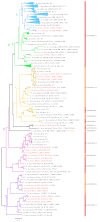Genome Analysis of Endotrypanum and Porcisia spp., Closest Phylogenetic Relatives of Leishmania, Highlights the Role of Amastins in Shaping Pathogenicity
- PMID: 33804709
- PMCID: PMC8004069
- DOI: 10.3390/genes12030444
Genome Analysis of Endotrypanum and Porcisia spp., Closest Phylogenetic Relatives of Leishmania, Highlights the Role of Amastins in Shaping Pathogenicity
Abstract
While numerous genomes of Leishmania spp. have been sequenced and analyzed, an understanding of the evolutionary history of these organisms remains limited due to the unavailability of the sequence data for their closest known relatives, Endotrypanum and Porcisia spp., infecting sloths and porcupines. We have sequenced and analyzed genomes of three members of this clade in order to fill this gap. Their comparative analyses revealed only minute differences from Leishmaniamajor genome in terms of metabolic capacities. We also documented that the number of genes under positive selection on the Endotrypanum/Porcisia branch is rather small, with the flagellum-related group of genes being over-represented. Most significantly, the analysis of gene family evolution revealed a substantially reduced repertoire of surface proteins, such as amastins and biopterin transporters BT1 in the Endotrypanum/Porcisia species when compared to amastigote-dwelling Leishmania. This reduction was especially pronounced for δ-amastins, a subfamily of cell surface proteins crucial in the propagation of Leishmania amastigotes inside vertebrate macrophages and, apparently, dispensable for Endotrypanum/Porcisia, which do not infect such cells.
Keywords: gene gain; gene loss; genome analysis; leishmaniinae.
Conflict of interest statement
The authors declare no conflict of interest. The funders had no role in the design of the study; in the collection, analyses, or interpretation of data; in the writing of the manuscript, or in the decision to publish the results.
Figures


Similar articles
-
An appraisal of the taxonomy and nomenclature of trypanosomatids presently classified as Leishmania and Endotrypanum.Parasitology. 2018 Apr;145(4):430-442. doi: 10.1017/S0031182016002092. Epub 2016 Dec 15. Parasitology. 2018. PMID: 27976601
-
Leishmaniinae: Evolutionary inferences based on protein expression profiles (PhyloQuant) congruent with phylogenetic relationships among Leishmania, Endotrypanum, Porcisia, Zelonia, Crithidia, and Leptomonas.Proteomics. 2024 Sep;24(18):e2100313. doi: 10.1002/pmic.202100313. Epub 2024 Jun 8. Proteomics. 2024. PMID: 38850190
-
The Leishmania hertigi (Kinetoplastida; Trypanosomatidae) complex and the lizard Leishmania: their classification and evidence for a neotropical origin of the Leishmania-Endotrypanum clade.J Eukaryot Microbiol. 1997 Sep-Oct;44(5):511-7. doi: 10.1111/j.1550-7408.1997.tb05732.x. J Eukaryot Microbiol. 1997. PMID: 9304821
-
Characterization of Endotrypanum (Kinetoplastida: Trypanosomatidae), a unique parasite infecting the neotropical tree sloths (Edentata).Mem Inst Oswaldo Cruz. 1999 Mar-Apr;94(2):261-8. doi: 10.1590/s0074-02761999000200026. Mem Inst Oswaldo Cruz. 1999. PMID: 10224540 Review.
-
Some current problems in the systematics of Trypanosomatids.Int J Parasitol. 2001 May 1;31(5-6):640-2. doi: 10.1016/s0020-7519(01)00137-0. Int J Parasitol. 2001. PMID: 11334956 Review.
Cited by
-
Shining the spotlight on the neglected: new high-quality genome assemblies as a gateway to understanding the evolution of Trypanosomatidae.BMC Genomics. 2023 Aug 21;24(1):471. doi: 10.1186/s12864-023-09591-z. BMC Genomics. 2023. PMID: 37605127 Free PMC article.
-
Genomics of Trypanosomatidae: Where We Stand and What Needs to Be Done?Pathogens. 2021 Sep 2;10(9):1124. doi: 10.3390/pathogens10091124. Pathogens. 2021. PMID: 34578156 Free PMC article. Review.
-
Comparative genomic analysis of trypanosomatid protists illuminates an extensive change in the nuclear genetic code.mBio. 2025 Jun 11;16(6):e0088525. doi: 10.1128/mbio.00885-25. Epub 2025 Apr 28. mBio. 2025. PMID: 40293238 Free PMC article.
-
Kinetoplast Genome of Leishmania spp. Is under Strong Purifying Selection.Trop Med Infect Dis. 2023 Jul 27;8(8):384. doi: 10.3390/tropicalmed8080384. Trop Med Infect Dis. 2023. PMID: 37624322 Free PMC article.
-
Comparative Analysis of Three Trypanosomatid Catalases of Different Origin.Antioxidants (Basel). 2021 Dec 26;11(1):46. doi: 10.3390/antiox11010046. Antioxidants (Basel). 2021. PMID: 35052550 Free PMC article.
References
Publication types
MeSH terms
Substances
LinkOut - more resources
Full Text Sources
Other Literature Sources
Molecular Biology Databases
Miscellaneous

